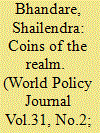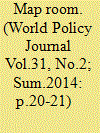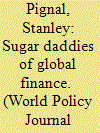|
|
|
Sort Order |
|
|
|
Items / Page
|
|
|
|
|
|
|
| Srl | Item |
| 1 |
ID:
133455


|
|
|
|
|
| Publication |
2014.
|
| Summary/Abstract |
OXFORD, England-We live in a globalized world where financial developments in one region can have an impact on a vastly different and geographically disparate location. The forces joining them are those of money, wealth, and finance, which are deeply interlinked, or so we tend to think. But the world around us has always been globalized, albeit to different degrees and involving different shades of financial undercurrents. An interesting prism to see this continual globalization is through the role itinerant and global currencies and monetary unions have played.
Money is often defined as "as any object (or record of that object) which is regularly used to make payments according to a law which guarantees its value and ensures its acceptability." Acceptance is thus at the core of any particular object being used as money. The spread of monetary traditions across regions happens because people from diverse locations accept particular monies, in the form of coins, paper, or other instruments, to make payments. The fact that coins can circulate as monetary objects greatly enhances their utility. They enable money to be spent and saved by facilitating their division.
|
|
|
|
|
|
|
|
|
|
|
|
|
|
|
|
| 2 |
ID:
133458


|
|
|
|
|
| Publication |
2014.
|
| Summary/Abstract |
Remittances to developing countries were a resilient source of external nancing during the recent global
financial crisis. According to the World Bank, remittances from developing countries are expected to reach $436 billion by the end of 2014. In this Map Room, World Policy Journal examines the in- ows and out- ows as a percentage of GDP in Asia. All percentages are based on World Bank and IMF 2012 data.
|
|
|
|
|
|
|
|
|
|
|
|
|
|
|
|
| 3 |
ID:
133457


|
|
|
|
|
| Publication |
2014.
|
| Summary/Abstract |
LONDON-One of the cornerstones of Marxist-Leninist thinking is that the state should control the "commanding heights" of an economy-industry, agriculture, infrastructure, and, perhaps above all, money and banking. That vision has largely perished, with one gaping exception. Government remains omnipotent in the financial system, not only on Wall Street or Threadneedle Street, but far beyond. Across the world, the state weighs in on all sides of the ledger, insuring both a bank's assets (mortgages and loans) and its liabilities (deposits). State intervention in banking ranges from muscular day-to-day regulation through to crisis-time bailouts, and is an entirely accepted feature of the financial system. Financiers complain about excessive red tape, because that is what all businessmen do. But absent the state's involvement in their sector, it is a safe guess far fewer would still be gainfully employed following the carnage of 2008. Those who survived would likely find their ensuing careers to be nasty, brutish, short, and entirely devoid of outsized bonuses.
|
|
|
|
|
|
|
|
|
|
|
|
|
|
|
|
|
|
|
|
|